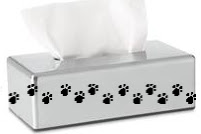Havanese and Allergies
 Havanese and Allergies – Truth or Myth?
Havanese and Allergies – Truth or Myth?
Published in Dogs in Canada Breedlines Jan/Feb/March 2006
Pet Allergies – You may have heard that Havanese are non-shedding and hypo-allergenic. You or other family members have allergies and/or asthma, so is a Havanese a good choice of pet for you? Maybe yes. but maybe not. An estimated 10 to 15 percent of the population is allergic to animals; even so, approximately 1/3 of these choose to live with at least one pet in their household. Choosing and living with a Havanese despite having allergies needs a basic understanding of pet allergies and a few sensible guidelines.
Understanding allergy triggers – Glands in the dog’s skin secrete tiny proteins, which can be allergy triggers in people with sensitive immune systems. These proteins linger on the dog’s body but also easily drift in the air. Proteins are also found in a dog’s saliva and urine. Sensitive individuals can be allergic to one or more of these proteins. Dander is the most common allergy trigger, followed by saliva and then urine.
Symptoms – Reactions to these protein allergens vary from one person to the next, ranging from very mild to severe. Reactions may include sniffling, sneezing, runny or stuffy nose, itchy and watery eyes, skin itch, rashes, hives, headaches, coughing and shortness of breath, wheezing, and life threatening asthma attacks. These can happen as quickly as a few minutes after exposure or as much as 24 hours or more later.
 Hypo-allergenic dogs? Contrary to long held belief, there is no dog breed that is truly non-allergenic. Seeing as all dogs of all breeds have skin and produce saliva and urine, they all have the potential of provoking allergic reactions in sensitive individuals. The term hypo-allergenic is typically used in reference to breeds such as the Havanese that appear to have a lower incidence of provoking allergic reactions. This may attributed in part to the breed’s tendency to have lower dander levels and shed less than other breeds. Many people refer to these as hypo-allergenic or allergy friendly breeds (meaning less likely to provoke an allergic response)
Hypo-allergenic dogs? Contrary to long held belief, there is no dog breed that is truly non-allergenic. Seeing as all dogs of all breeds have skin and produce saliva and urine, they all have the potential of provoking allergic reactions in sensitive individuals. The term hypo-allergenic is typically used in reference to breeds such as the Havanese that appear to have a lower incidence of provoking allergic reactions. This may attributed in part to the breed’s tendency to have lower dander levels and shed less than other breeds. Many people refer to these as hypo-allergenic or allergy friendly breeds (meaning less likely to provoke an allergic response)
Does that mean that anyone with allergies can add a Havanese to their family without concern of experiencing allergic reactions? Not at all; if you or a family member have ever experienced an allergic reaction to any dog or other animal, it is wise to check for potential allergies to Havanese before choosing to add one to your family. Even though allergic reactions to Havanese may be less common, they can and do happen. Lets look at what else needs to be considered and how Havanese can potentially trigger allergies in sensitive individuals.
Allergy Triggers
If Havanese are considered low dander or hypo-allergenic, why can a sensitive individual still get a reaction to them? A review of the potential Havanese allergy triggers may give better understanding.
Dander – what is it? Dander is small particles of dead skin cells that flake off the body as the skin regenerates itself. If dogs have skin, they will produce dander. Some breeds of dog like the Havanese seem to produce low(er) amounts of dander, however; it must be kept in mind that individual dogs produce individual amounts of dander. This means that one Havanese may be more irritating to an allergic individual than another Havanese. Tiny, almost invisible flakes of dander can also float through the air.
Fur – Some very few people may be specifically allergic to dog fur. Contrary to popular belief, rather than reacting to the fur itself, allergic individuals are likelier to be reacting to allergens that cling to the fur. Similarly, it is not specifically the amount or length of hair that causes allergic reactions. While a full coated Havanese does not necessarily produce more dander than a Havanese with a clipped coat, because of the volume, it has more space to hold dander and may also pick up and carry other allergens more easily. The long luscious Havanese coat can pick up an amazing amount of debris in the yard and on walks or playtime in the park including grass, seeds, dust, pollen, molds and other allergens which may be additional triggers for allergic individuals.
Shedding – If fur is not specifically an allergen, what does shedding or non-shedding have to do with allergies?
Dogs that shed profusely may leave more hair everywhere so allergens carried by the hair are naturally distributed more widely than by breeds of dog that shed less. Note: Havanese which carry the short hair gene (a genetic mutation) seem to produce more dander and also shed more than the coated Havanese.
Saliva – Havanese form very strong bonds to their families and can be very expressive in their love with lots of kisses and licking which can be an issue with saliva sensitive individuals. It’s important to know that saliva protein can be transmitted not only by licking but also by residue which lingers on the skin and fur from self grooming. Some Havanese do self groom extensively.
Urine – Urine protein is the least likely to provoke allergic reactions since housebroken Havanese eliminate outdoors or in designated areas and there is minimal direct contact. However, urine residue on the belly or leg fur may cause unexpected problems in sensitive individuals. This may also be an issue around young puppies before they are reliably housebroken.
Can You Live With a Havanese?
Check for reactions – Tell the breeder about your allergies when you visit. Stay as long as possible; hold, hug, cuddle and kiss all their Havanese, puppies and adults. Rub your face into their fur; let them lick you, especially the sensitive skin on your face and neck and inside your arms. This will test your allergic reaction to dander and saliva and help you to determine a basic allergy level to Havanese. A mild reaction does not necessarily mean you cannot live with Havanese. It may simply mean you need to check further. While some mildly sensitive individuals can tolerate 1 or 2 Havanese with few problems, they may not be able to tolerate a houseful. A visit perhaps with a pet owner who only has one Havanese is a good next step. If, upon careful checking, you are highly sensitive to Havanese, it is probably best to avoid getting one and look to other breeds if you are determined to add a dog to your family. (the ideas presented below are not to be considered as long term solutions for highly allergic individuals)
Living with allergies to your pet – Many people with only mild, tolerable allergic symptoms can live with a low dander minimally shedding Havanese with proper environmental controls. Here are a few ideas to help reduce allergens on the dog and in the home to minimize triggers.
- First and foremost, keep your Havanese clean and groomed. Regular brushing helps remove loose and dead hair and the allergens carried by them. Bathing your Havanese every 7-10 days can reduce levels of fur borne allergens by as much as 80%.
- If possible, groom in a specific area, a dog room with a closed door to minimize allergens loosened during grooming from becoming airborne throughout the home. Ideally, a non-allergic family member should do the grooming as well as the cleaning of this room afterwards. Even better, bath day can be done at a self-wash station of a local pet store.
- Daily or weekly use of products that claim to reduce allergens when sprayed on an animal’s fur may be helpful for some, though studies show they are less effective than weekly bathing.
- Regular, thorough cleaning of the home as well as the use of heating and air-conditioning filters and HEPA filters are all ways of reducing allergens. An anti-allergen detergent for pet laundry may be another good idea. – It makes sense that saliva sensitive people discourage their Havanese from kissing or licking them, especially on the face and neck; also important to wash hands thoroughly after handling or playing with the dog. For fur and dander sensitive individuals, the Havanese should be kept out of the bedroom and off the bed to keep the bedroom a dog free zone.
- Many allergy sufferers are sensitive to more than one allergen including dust, pollen, smoke etc in which case the overall allergen level in the environment must be reduced by concentrating on all of the causes, not just the pet allergy.
- A combination of methods is most likely to succeed in allowing a mildly allergic person to live with a Havanese.
